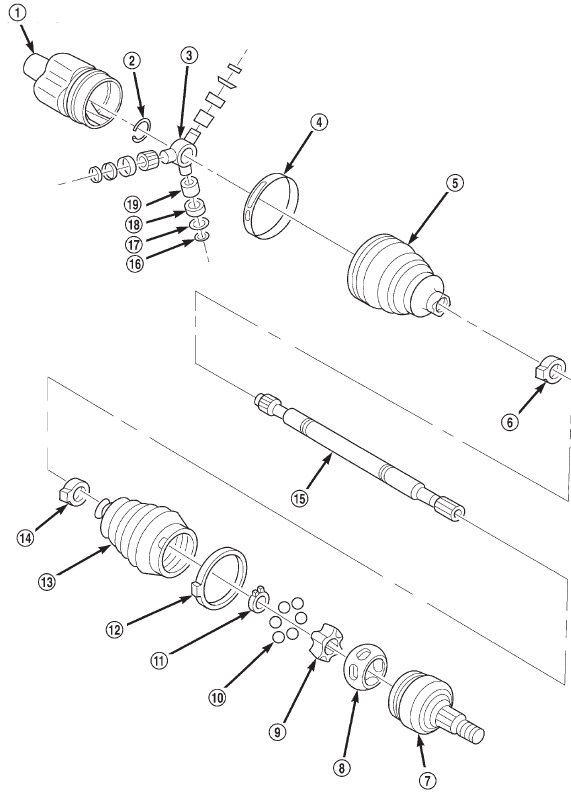Description and operation. Diagnosis and testing
Front axle driveshafts DESCRIPTION The two constant velocity (C/V) drive shafts are
identical and interchangeable. They are comprised of
three major components (Fig. 1) : The inner tripod-joints are attached to the axle
shaft splines (Fig. 1). The outer joint is splined and
mates with the hub bearing on the knuckle.
The lubricant amounts included with replacement
rubber boots are different for inner and outer C/V
joints. Apply only the specified lubricant amount to
each C/V joint. CAUTION: Proper C/V joint boot sealing is critical
for retaining the special lubricant. Prevent foreign
material from entering and contaminating the C/V
joints. Mishandling a C/V drive shaft can cause a
boot to be punctured or damage within the joints.
Always support both ends of the C/V drive shaft
during removal and installation to avoid damage. When replacing C/V drive shaft components,
ensure that only exact replacements parts are
installed. OPERATION The axle driveshafts are located on either side of
the differential and transmits power to the drive
wheels, while allowing for vertical movement in the
vehicle's suspension. (1) Check for grease in the vicinity of the inboard
tripod joint and outboard C/V joint; this is a sign of
inner or outer joint seal boot or seal boot clamp damage. (2) A light film of grease may appear on the right
inner tripod joint seal boot; this is considered normal
and should not require replacement of the seal boot. A clicking noise and/or a vibration in turns could
be caused by one of the following conditions: This noise may be a result of one of the following
conditions: This problem could be a result of:
1 - RETAINER & HOUSING ASM 2 - C-CLIP 3 - TRIPOD JOINT SPIDER 4 - SEAL RETAINING CLAMP 5 - INNER BOOT 6 - SEAL RETAINING CLAMP 7 - C/V JOINT OUTER RACE 8 - C/V JOINT CAGE 9 - C/V JOINT INNER RACE 10 - CHROME ALLOY BALL 11 - RACE RETAINING RING 12 - SEAL RETAINING CLAMP 13 - DRIVE AXLE OUTBOARD SEAL 14 - SEAL RETAINING CLAMP 15 - AXLE SHAFT 16 - RETAINING RING 17 - BALL & ROLLER RETAINER 18 - TRIPOD JOINT BALL 19 - NEEDLE ROLLER This problem could be a result of:Description and operation
Diagnosis and testing
Vehicle inspection
Noise and/or vibration in turns
Clunking noise during acceleration
Shudder or vibration during acceleration
 Fig. 1 C/V Drive Shaft Components
Fig. 1 C/V Drive Shaft Components
Vibration at highway speeds
Dodge Durango (DN) 1998-2003 Service Manual
- Lubrication and Maintenance
- Suspension
- Differential and Driveline
- Brakes
- Cooling System
- Battery
- Starting Systems
- Charging System
- Ignition System
- Instrument Panel Systems
- Audio Systems
- Horn Systems
- Speed Control System
- Turn Signal and Hazard Warning Systems
- Wiper and Washer Systems
- Lamps
- Passive Restraint Systems
- Electrically Heated Systems
- Power Distribution System
- Power Lock Systems
- Vehicle Theft/Security Systems
- Power Seat System
- Power Window Systems
- Power Mirror Systems
- Chime/Buzzer Warning Systems
- Overhead Console Systems
- Engine
- Exhaust System
- Frame and Bumpers
- Fuel System
- Steering
- Transmission and Transfer Case
- Tires and Wheels
- Body
- Heating and Air Conditioning
- Emission Control Systems
- Introduction
